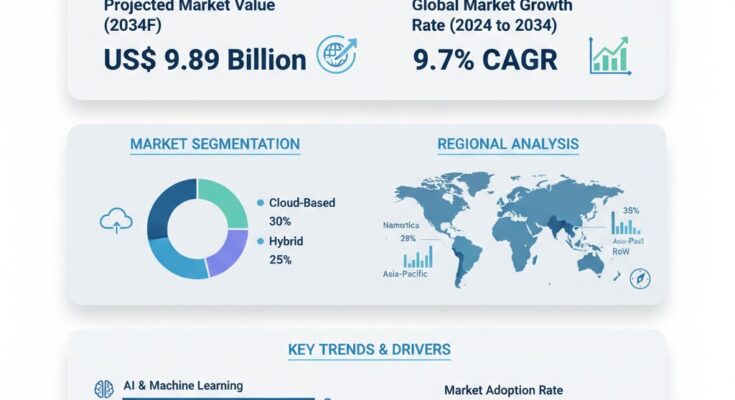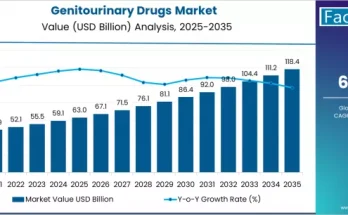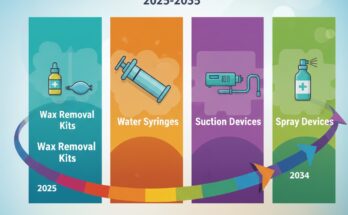The global medical image exchange system market is poised for rapid expansion as healthcare systems worldwide continue their digital transformation journey. According to a recent report by Fact.MR, the market size is estimated at US$ 3.91 billion in 2024 and is projected to climb to US$ 9.89 billion by 2034, reflecting a robust CAGR of 9.7% during the forecast period.
Driven by the increasing need for seamless image sharing across hospitals, diagnostic centers, and research institutions, medical image exchange systems are redefining how clinicians access, analyze, and collaborate on patient imaging data.
Strategic Market Drivers
- Rising Need for Interoperability and Efficient Data Management
The growing adoption of electronic health records (EHRs) and digital imaging has created a strong need for interoperable systems that can enable secure and efficient image sharing.
Hospitals and imaging centers are increasingly leveraging cloud-based medical image exchange platforms to improve care coordination, minimize diagnostic delays, and reduce redundant imaging procedures.
Advanced systems offer real-time collaboration between physicians, allowing immediate access to radiology images, CT scans, MRIs, and X-rays—enhancing diagnostic accuracy and patient outcomes.
- Expansion of Telemedicine and Remote Diagnostics
The surge in telehealth services, particularly post-pandemic, has fueled the demand for robust image exchange platforms. These systems facilitate remote consultations by enabling specialists to view and interpret imaging data from anywhere in the world.
Healthcare providers are integrating these solutions with telemedicine platforms to streamline workflows and ensure compliance with HIPAA and GDPR data security standards.
- AI Integration and Cloud Technology Advancements
The integration of artificial intelligence (AI) into image exchange systems is transforming diagnostic workflows. AI-assisted image tagging, automated anomaly detection, and predictive analytics are improving the efficiency of medical imaging operations.
Cloud-based infrastructure further enhances scalability, allowing institutions to store, share, and retrieve large imaging datasets seamlessly across multiple locations while reducing IT infrastructure costs.
Regional Growth Highlights
North America: Technological Leadership and Advanced Healthcare Infrastructure
North America dominates the global market, driven by high adoption of cloud-based solutions, strong regulatory compliance frameworks, and advanced healthcare digitization.
The United States leads with significant investments in healthcare IT, interoperability standards, and vendor-neutral archives (VNAs), ensuring secure medical data exchange between different healthcare systems.
Europe: Regulation-Driven Integration and Cross-Border Data Exchange
Europe’s focus on interoperability and cross-border healthcare data sharing under the EU Health Data Space initiative is driving market growth. Countries such as Germany, the U.K., and France are implementing advanced exchange systems to improve diagnostic collaboration and reduce imaging redundancies across healthcare networks.
Asia Pacific: Rapid Healthcare Digitization and Infrastructure Development
Asia Pacific is emerging as a high-potential market due to expanding healthcare infrastructure, digital health initiatives, and increasing government investments.
Countries like China, India, and Japan are witnessing rising adoption of PACS (Picture Archiving and Communication Systems) and cloud-enabled exchange platforms to bridge the gap between urban and rural healthcare services.
Emerging Markets: Growing Adoption of Cloud and Mobile Health Platforms
Regions such as Latin America, the Middle East, and Africa are experiencing gradual uptake of medical image exchange systems, driven by healthcare modernization programs and international collaborations for telemedicine services.
Market Segmentation Insights
By Deployment Type
- Cloud-based Systems: Fastest-growing segment due to scalability, cost-efficiency, and remote accessibility.
- On-premise Systems: Preferred by institutions requiring higher data control and compliance with local regulations.
By End User
- Hospitals and Clinics: Major users for diagnostic sharing and collaboration.
- Diagnostic Imaging Centers: Adopting exchange systems to enhance patient data access.
- Research and Academic Institutions: Leveraging image sharing for multi-center clinical studies.
Challenges and Market Considerations
Despite rapid advancements, several challenges persist in the market:
- Data Security and Privacy Concerns: Compliance with HIPAA, GDPR, and regional data protection regulations remains a top priority.
- Integration Complexities: Interfacing legacy systems with modern exchange platforms requires significant investment and expertise.
- Cost Barriers in Developing Economies: High implementation and maintenance costs can restrict adoption in low-income regions.
- Bandwidth Limitations: Large imaging files require strong network infrastructure for efficient sharing.
Competitive Landscape
The global medical image exchange system market is characterized by strategic mergers, acquisitions, and partnerships aimed at expanding product portfolios and global reach. Leading vendors are focusing on enhancing interoperability, AI integration, and user experience.
Key Companies Profiled:
- Nuance Communications Inc.
- IBM Corporation
- PaxeraHealth
- GE Healthcare (A General Electric Company)
- Sectra AB
- Trice Imaging Inc.
- eHealth Technologies Inc.
- IMEXHS
- Vaultara
- Koninklijke Philips N.V.
- Change Healthcare
- DICOM Grid Inc. (dba Ambra Health)
- DataFirst
- OneMedNet Corporation
Recent Development:
In September 2022, Intelerad Medical Systems acquired Life Image, one of the world’s largest medical and clinical image exchange networks. This acquisition marked a major step toward creating a unified, interoperable global platform for medical imaging data.
Future Outlook: Toward a Connected and Intelligent Imaging Ecosystem
The next decade will see medical image exchange systems evolve into intelligent, interconnected platforms powered by AI, cloud computing, and blockchain technologies. These innovations will enhance data integrity, streamline collaboration, and personalize patient care.
As healthcare providers prioritize interoperability and real-time data access, vendors that invest in secure, scalable, and AI-driven exchange solutions will lead the next wave of digital healthcare transformation.
With strong market momentum and expanding applications across healthcare domains, the global medical image exchange system market is set to revolutionize medical imaging—enabling faster, smarter, and more connected care delivery worldwide.



